 |
Please note : There are lots of large pictures on this page
that may take some time to download if using a dial up connection.
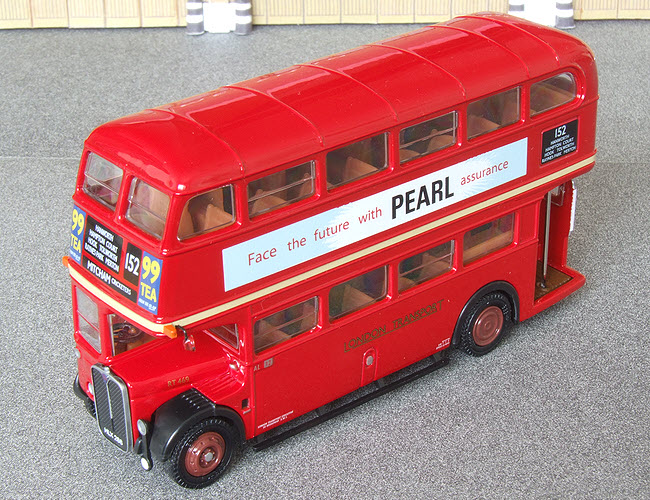
34101 RT469 the newly retooled 3RT AEC Regent
|
A Brief History
The Post War 3RT
The delivery of the new 2RT2s was curtailed after only 150 had been built due to outbreak of the Second World War, there then followed a gap of almost six years before the next new members of the RT class arrived in 1946, the early post war 3RT buses bore a very close resemblance to the original batch and had the same roof box and front destination blind layouts, the most notable change was a revised driver's windscreen and side window designs which eliminated the downward curve on the bottom edges.
The off-side headlamp was also repositioned and more neatly incorporated into the front panel below the windscreen rather than being slung low down beside the radiator. The slight inward curve on the lower panels behind the rear axle were also replaced by much simpler straight panels.
In 1948 a revised blind arrangement was introduced which did away with the need for the roof boxes, this was adopted as standard on all the future deliveries of the RT. In all well over 4500 RTs were produced of which 3100 were to the non roof box design, the class eventually became the biggest ever operated by London Transport and many of the vehicles lasted well in excess of 30 years.
The last survivors were finally withdrawn from public service on route 62 at Barking garage with great ceremony in April 1979. Many RTs have been preserved and are still a familiar sight at various vintage running days and bus rallies today.
A more detailed history of the 3RT type buses complete with individual vehicle histories can be found the excellent Ian's Bus Stop website. |
|
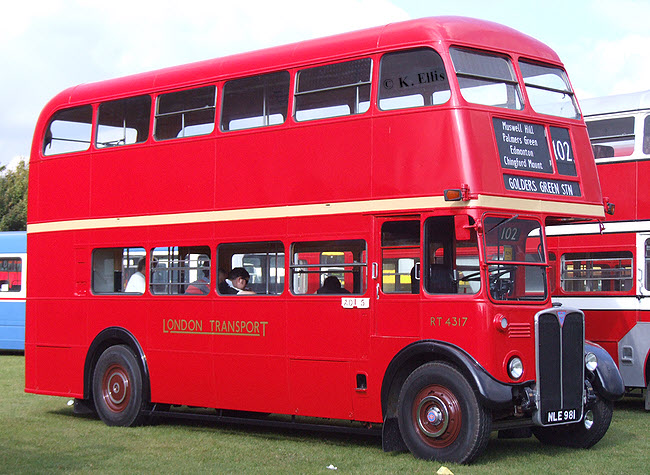
Preserved RT4317 at the 2008 Duxford Showbus Rally
|
The Model
The model reviewed here is the first release of the newly retooled casting, this particular model, cat no. 34101, was released by EFE as the special model for the 2008 Showbus Rally. At the time of writing it's still not clear if any surplus stock will be made available to the normal model retailers. A second green London Country version has already been announced and will go on general release in due course.
This first model portrays RT469, a non roof box version, at work on Merton Depot's route 152 bound for Mitcham Cricketers, it wears the standard all red livery with cream between decks band and gold underlined fleet names. The style of route blinds and period advertisements suggest the model depicts the bus during the early 1960s. |
|
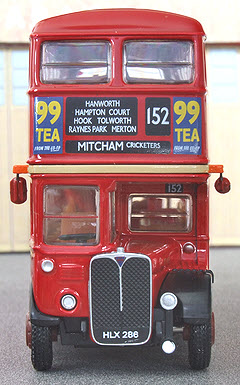 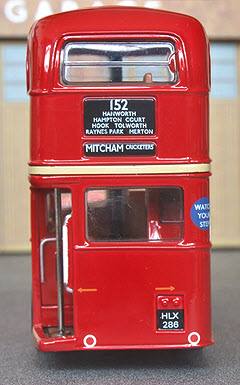
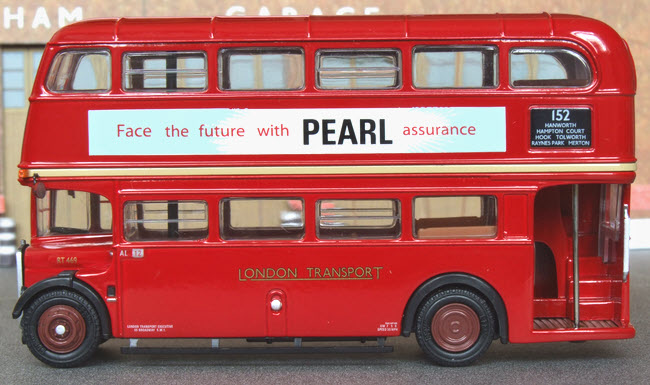
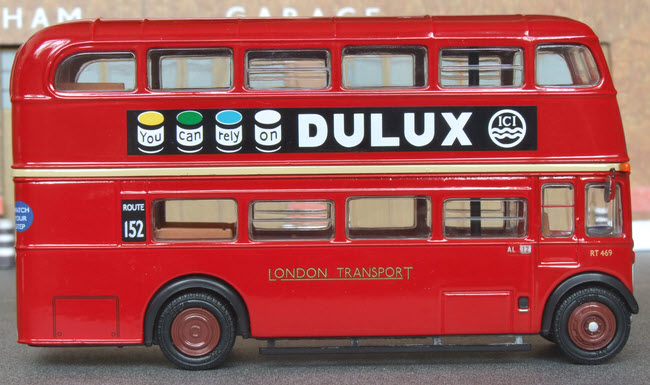
|
|
The first thing that becomes obvious is that this model is very similar to the earlier 2RT2 one, the basic castings seem to share a common origin with a just a few alternations applied to depict the main differences between the two types.
The area that differs the most is around the off-side front corner, were a straight horizontal lower edge is correctly used for the windscreen and cab side windows. There have been some other fairly major changes to the panel below the windscreen during the retooling and on the whole these have much improved the front end appearance, the panel had previously been rather over rounded on the lower off-side corner and comparing new and old models now highlights how poorly this was originally reproduced. Although this improves things greatly it's sad to say that its still not quite perfect, the lower edge of this panel should slightly curve upwards as it travels between the headlamp and the radiator, unfortunately on the model the panel has a completely straight lower edge that is more akin to that found on the earlier 2RT2s.
The front mudguards are now narrower and are a vast improvement over the rather chunky originals, they still however look a little on the short side to me and the ends still look a little too squared off.
Further minor tweaking appears to have been carried out on the lower deck casting around the top of the near side front mudguard giving a much smoother joint between the plastic & metal components. |
|
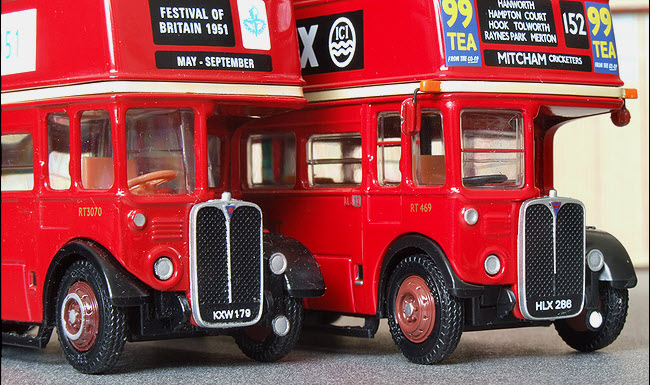
Note the improved steering wheel position and lower off-side corner treatment

The front mudguards are now slightly narrower and are more accurate as a result
when compared with the earlier version but still look a bit on the short side.
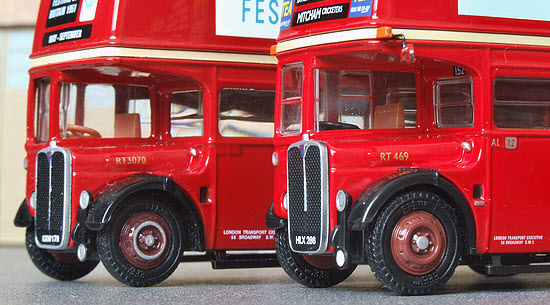
The retooled version now has a smoother joint between the body & the top,of the near side mudguard
|
|
The rear now of cause has a glazed platform bulkhead and as per the 2RT2 a proper recessed area under the staircase, the platform floor has once again been picked out in brown paint and looks much better than bare black plastic, unlike the recent RLHs the staircase area has been left in plain red body colour rather than receiving a coat of brown paint. Again I feel this detailing would have improved the platform area even further had it been used.
The grab handle on the rear panel has been nicely detailed this time with a white central grip, it's support poles have been picked out with silver paint and this little touch greatly adds to it's appearance when compared to the all white finish applied on the 2RT2& RLH models. Now if we could just have a little more white paint on the silver platform pole and a "Used Tickets" sign on the bulkhead receptacle we'd just about have everything covered. |
|
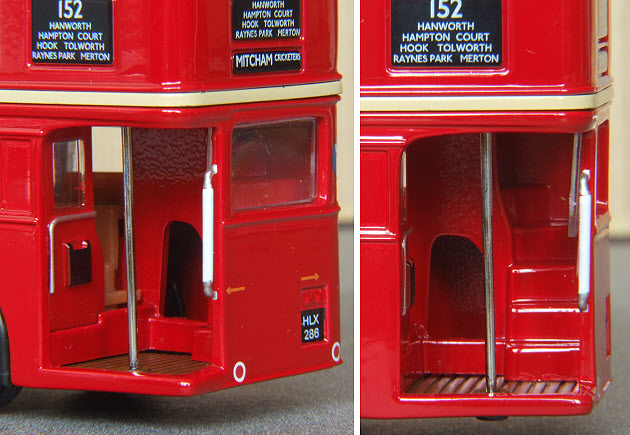
|
|
The base plate appears to be identical to that used on the 2RT2 model and apart from the aforementioned front mudguards seems little altered from that used on earlier versions of the RT/L models.
|
|
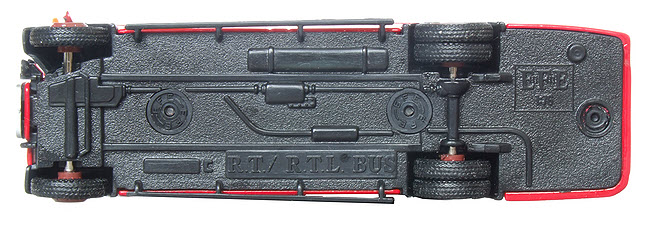
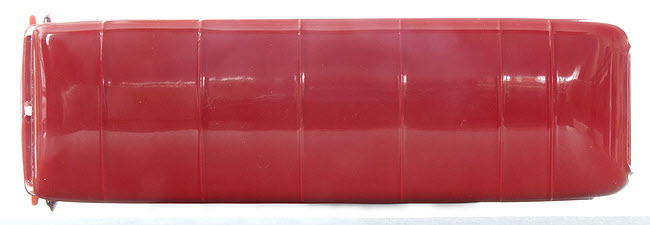
|
|
The tampo printing is again well up to EFE's normal high standards and includes the now familiar and nicely scaled black outlined gold fleet names. The period advertisement are nicely reproduced and it's nice to see two different ones used on either side, my only criticism here is the lack of rear advertisements which leaves the rear end looking a little on the Spartan side and would in reality be somewhat untypical for a London Bus of the period portrayed. A rear corner spot "watch your step" poster is a nice touch although to my eyes this looks slightly over sized.
Tiny but fully legible London Transport Executive legal lettering and weight details appear on the lower near side panels.
Garage codes & running number plates showing AL 12 are carried in the correct positions on each side of the bus while on the front a tiny AEC badge has been reproduced on the radiator along with the registration number.
The near side bonnet fleet number is applied to a raised area to depict the cast bonnet plates fitted to the RTs, a tampo printed surround as used on the STL might have been something that might enhanced it's appearance further.
The front sidelights are picked out with silver paint as is the near side fuel filler cap and plates on foot holds. The tail lights above the rear number plate are cast but have been left in the main red body colour. Two orange indicator arrows have however been printed on the rear panel along with a pair of reflectors, these are features I've not seen before on previous releases and are a nice touch although the reflectors do look a little on the heavy side.
The treatment given to the front lights is a little odd, the front face of the head lamps are painted silver as you'd expect but unusually the lower near side fog lamp is for some reason painted white which seems a little inconsistent. |
|
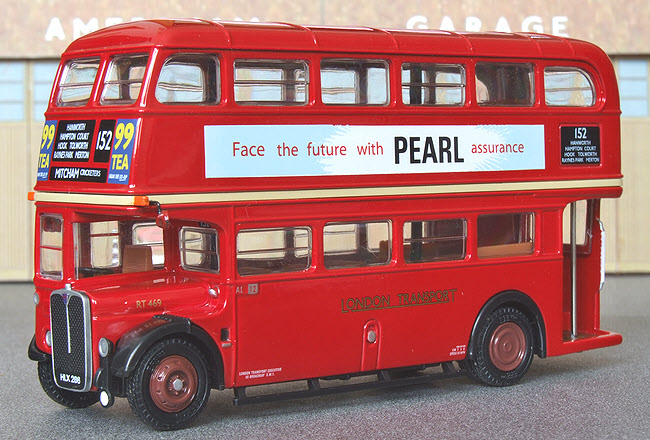
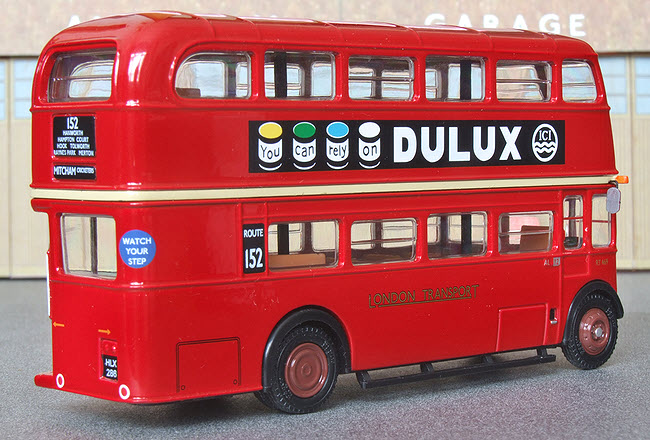
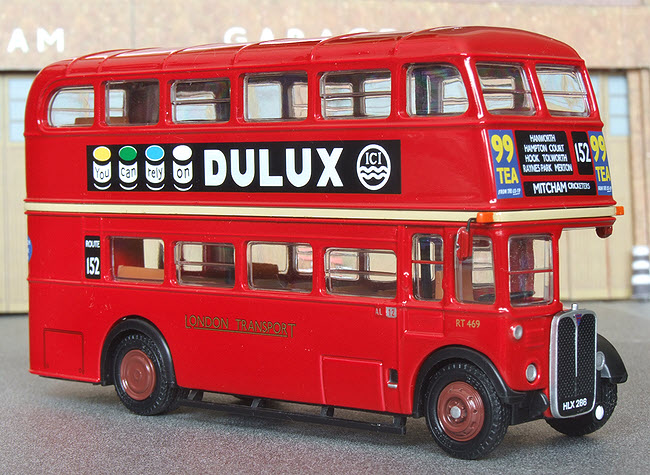
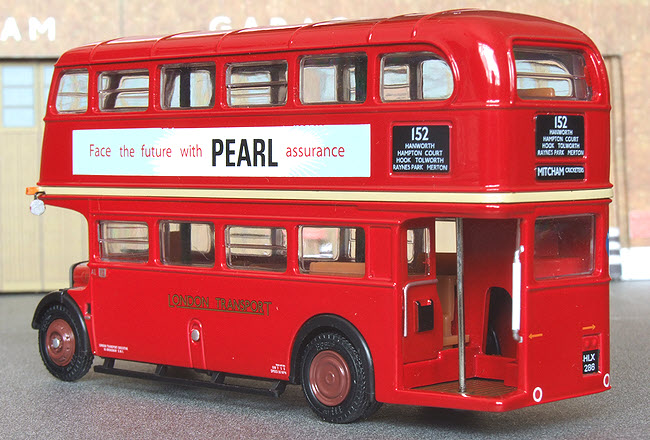
|
|
A full set of blinds for route 152 are present and contain capitalised main terminal and smaller via points in the correct style and layout. The near side and rear blind box outlines are moulded into the upper deck casting but this extra detailing hasn't been repeated on the front no doubt to allow for different blind layouts. In a similar vain the battery box access hatch on the off-side staircase panel is now a tampo printed detail and actually looks much neater than the similar cast one behind the driver's cab door. |
|
|
Flusher glazing is now fitted to the model and this includes moulded window vents, these unfortunately haven't been picked out with silver paint on this model, something that improved their appearance on the earlier 2RT2 version.
Finally after the RLH with its full panel beading the lack of any such detail on this model leaves the sides in particular looking rather under detailed, I know the beading wasn't heavy on the real buses but it was non the less still an eye catching characteristic that became more prominent as the paint work aged and I'd really have liked to seen these modelled.
Like the 2RT2 the 3RT model isn't a perfect reproduction but its still a major improvement over the previous two incarnations and manages to capture the essence of these classic buses rather well. It will no doubt be welcomed by many London bus enthusiasts but some may be left feeling that an opportunity to produced an even better final product has once again been missed because of a few minor shortcomings.
|
|

|
| Model Review Index |

















